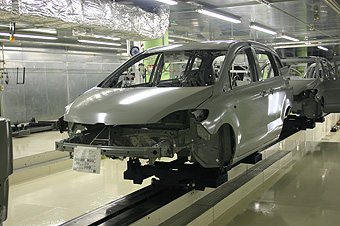NEWS RELEASES
Products and Technology
Mazda Adopts More Eco-Friendly Painting Process
-Active torque control coupling 4WD system attains better performance and stability on icy roads-
HIROSHIMA, Japan--In collaboration with the Nippon Paint Company, Mazda Motor Corporation has developed a new electrodeposition basecoat--known as e-coating--that substantially reduces both volatile organic compounds (VOC) and carbon dioxide (CO2) emissions. Raising Mazda’s painting process to a new world standard, e-coating efficiently adheres paint to metal surfaces and raises the rust protection quality of Mazda vehicles. The launch of this new painting technology began in May 2005 at the Ujina No.2 Plant at Mazda’s global headquarters in Hiroshima, and will be extended to all of its main production facilities in Japan by the end of 2005.
Mazda has already completed the introduction of its world-first “Three Layer Wet Paint System” to all of its plants in Japan. The Mazda Three Layer method combines the primer, base and clear coats into one painting process, significantly reducing the burden on the environment. With the Three Layer painting system and the new e-coating process, Mazda is aiming to be greener in its manufacturing policies and also improve the rust protection quality of its vehicles. By employing these two technologies, Mazda’s painting process has advanced to a new level of eco-friendliness.
The introduction of this e-coating technology results in several advantages:
Outline of the new e-coating technology Using an electrical charge facilitates an excellent paint-to-metal bond, and is generally used to help prevent corrosion on all body surfaces. However, with conventional paints, discrepancies in paint film thickness can result between the inside and outside body surfaces because it is difficult for electrical currents to reach all interior parts and form an even paint film on interior surfaces. The newly developed e-coating has modified paint characteristics that raise the paint’s electrical resistance, enabling the electrical current to reach inner surfaces more easily and reducing the amount of electricity used during painting. This provides sufficient paint thickness on inside surfaces and increases rust protection. Optimal paint thickness is usually achieved on vehicle body outer surfaces because the electrical current flows more easily to exteriors than to internal areas. Prior to the introduction of the new e-coating system, excess paint accumulated on outer surfaces during conventional painting. With e-coating, the thickness is better regulated, allowing for a reduction in the total amount of paint necessary. |
